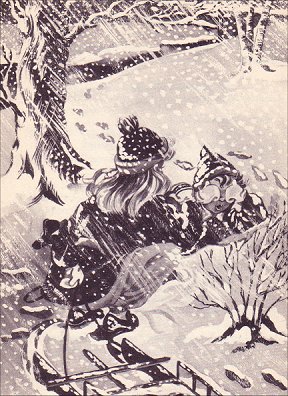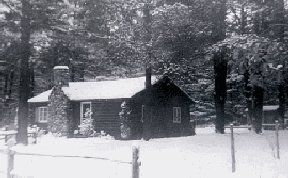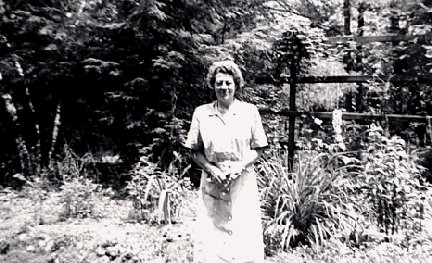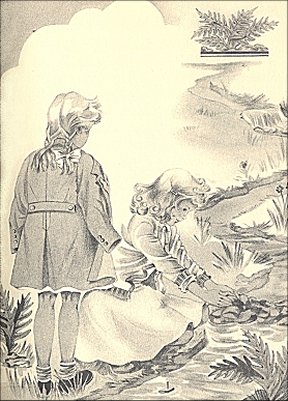

|
<<< Continued from previous page A year or so ago BookThink's Associate Editor Pamela Palmer introduced me to this long out-of-print book and recently loaned me her copy to read. I must tell you that, under anything approaching normal circumstances, this isn't the sort of book I would ever sit down to read; rather, it's a book young girls would ... devour - that is, if they knew about it. The trouble is that almost nobody does know about it, let alone the other five books Marshall wrote. Not that it would matter much if you did because you might be hard put to find a copy of it anyway or, at best, forced to pay well over $100 for the pleasure of the read - yes, no matter what the edition state, and ex-library copies are fine, thank you. Given that The Long White Month was first published by E.P. Dutton in 1942, went through sizable and multiple printings, was reviewed/recommended by, among other notables, The New York Times, and purchased in large numbers by libraries, it's surprising that this book or any Marshall book has never been reprinted. Meanwhile, an enthusiastic fan base of readers keep things hopping for us booksellers. It's hard to let this thought go: Somehow you'd think this would get noticed. Assuming that Dutton (or Penguin, who acquired Dutton some years ago) still retains copyright, wouldn't it make sense to reprint it? And sooner than later? If another 15 or 30 years go by without a reprint, it's far more likely that this book will be permanently lost because those young girls (and sometimes boys) who first delighted in it in the 1940s and early 1950s won't be with us anymore, and who will be left to point the way back to it? And what a shame that would be because, having read it myself, I can report that it's one of the best examples of its kind I've ever read - and it's so good that Pam herself rereads it every Christmas. (See Pam's article following this.) This isn't Dostoevsky. The plot couldn't be simpler. Orphaned Priscilla, a sheltered city girl who lives with her aunt, is shuttled off to stay with her cousin in a marginally primitive cabin in the woods for an entire month, takes on the role of caretaker to 100s of wild birds, and, along the way, discovers an ingenuous joy of living she'd never experienced before. As the story proceeds, an undercurrent of tension slowly builds as Priscilla becomes more and more enamored of her new life but also increasingly aware that her precious month is fast running out. And so the page turning begins. There's also adventure here. When her friend Ann takes off unexpectedly to feed Priscilla's birds, an alarmed Priscilla goes after her. The darkening woods fill up with snow: Again she shook her head, and realized suddenly, with sharp alarm, that she was trying to shake snow from her eyelashes. It was snowing again, hard. Well, suppose it was? A little more snow wouldn't hurt her. The woods were growing darker. She had to walk all bent over to see the tracks. No, it wasn't really darker, was it? It was just that the snow kept getting in her eyes. It was so thick all around her, like a wavy veil. It was talking to her, with a little murmuring sound. She bumped into a tree and caught her breath sharply. She hadn't seen that tree at all. She leaned against it for a moment. How far had she come? It seemed miles. It seemed hours. Why, how silly she was! Why didn't she call Ann? Perhaps she wasn't very far ahead of her. Perhaps she was quite near her. "Ann! Ann!" Over her head a hemlock branch shivered and dropped a feathery handful of snow on her shoulders. She could not see it, but she felt its soft weight. "Ann! Ann!" A little movement went through the woods; a whisper of an echo; then silence. The veil around her was thicker and dimmer. She stooped to find the track. Yes, there it was. But it wasn't so deep now. The new flakes were gently and quietly filling it up. In sudden panic, Priscilla plunged onward. The weight of the sled, so light at first that she had hardly felt it, now dragged behind her, heavy as iron. Why had she brought it, anyway? She opened her cramped hand to drop the rope, but something inside her warned her to hold fast. "Ann! Where are you?" The snow murmured its soft, unheeding answer. A few broken lines of poetry from her big book said themselves over and over in her head:
"There was a fairy, flake of winter, The strange, cold words kept slipping in and out of her thoughts. Fairy flakes. She could hear them whispering, like the Snow Queen's army. Priscilla stumbled over a snowy hump. She caught herself against a tree and jerked her mind out of its confusion. Where was the track? Peer as she would, she couldn't see it. Had she lost it in her weariness? She turned about. She must go back and find it. But she hadn't lost it. She could see it be-hind her, her own fresh' footprints beside it. But it didn't go on. It went backward, but not forward. It just ended, there where Priscilla had stumbled over the big root, or whatever it was. Panic gripped her now. What could make footprints disappear off the ground like that? "There was a fairy, flake of winter -" Fairies had wings. Something with wings could fly away with a little girl, and leave no tracks. "They stole little Bridgit for seven years long -" Fairies did steal children. But fairies weren't real. How silly she was being! She sighed a wavery sigh and gathered up her wits. The great owl had wings. Was that his voice she heard far off in the swamp? "Hoo, hoo-hoo-hoo, hoo, hoo!" She turned on herself violently. The biggest owl in the world couldn't carry off sturdy little Ann. "Ann! Ann! Where are you?"

It's my sincere hope that the tracks Dean Marshall left on the literary landscape will not be covered by the snows of time. Perhaps we need to resurrect the formidable Bulwer-Lytton to proclaim to all, "Hail! all hail Dean Marshall!" One devoted fan of Marshall's, Jim Cameron, has built a website devoted to her and her work, in part to keep the legacy alive. Jim would appreciate any additional information on Marshall or her work, and he can be contacted on the website. The following is a brief biography he wrote for this issue: Miss Clara Dean Marshall was born in 1900 in Louisville, Kentucky. She graduated from Vanderbilt University and attended the New York School of Social Work. Soon after she was associated with the New York Charity Organization Society and later was case supervisor for the Hartford C.O.S. She lived and wrote in northern Connecticut, near Granby, in a log cabin in the "Granby Woods."

The house was in rather poor repair, but Dean loved living on the lake surrounded by nature. She was known as a bit of an eccentric, sleeping every night, summer and winter, on the porch, bundled up in blankets as necessary. Nancy Hall Chumachenco, whose mother was a lifelong friend of Dean's, confirmed in a recent article that this cabin was indeed the model for the cabin in her second book, The Long White Month. Dean worked in Hartford with needy children during the war, taking a break from her writing for much of the war's duration. It was during this time that she conceived the idea for her third book, The Invisible Island, which was based on childhood memories growing up in Kentucky. The setting of The Invisible Island and its sequels, Dig for a Treasure and Wish on the Moon, are based on a lake and an "invisible" island that actually existed behind her log cabin in Connecticut. Dean was an avid bird lover as well as a keen observer of nature, and this is perhaps reflected best in The Long White Month. Although she was born and raised in the South, she loved the New England landscape and its people. Her characterizations of Yankees are insightful and humorous. All of her books are set in New England except for A House for Elizabeth, which is largely set in rural Kentucky. She did not publish anything after Wish on the Moon in 1951. She spent many years caring for her elderly parents, all three of them living in her small log cabin. We may never know why she stopped writing, but one friend suggested that it may have been because of the demands of caring for her parents, a responsibility which grew only more burdensome over time. Dean worked for many years as the librarian in the children's room of the Granby library, even well into her 80s. She encouraged children to write as well as to read, and she put together and edited a book of children's stories that was published in small numbers by the library and sold locally. Despite living many years in New England, she never lost her southern accent. She loved children, and continued to correspond with her young friends who lived near and around Lake Basile well into their adulthoods. She was deeply beloved by them. After her parent's deaths, Dean lived alone in the cabin until at least 1988. Gradually, her beautiful flower garden became overgrown from lack of care, and finally, not long after her 90th birthday, she reluctantly moved in with her grand niece, who lived in Arizona, where she died in 1994 at the age of 95.

Buying and Selling Dean MarshallAll six of Dean Marshall's books were published by E.P. Dutton. Three of these, The Silver Robin, The Invisible Island, and Dig for a Treasure, were also issued as book club editions bearing the imprint "Published by The Junior Literary Guild and E.P. Dutton & Company," and two, The Long White Month and The Invisible Island were also published by E.M. Hale, a well-known publisher of library editions. During the period in which Marshall was writing, E.P. Dutton first editions were indicated by the statement "FIRST EDITION" appearing immediately below the copyright notice on the title page verso. Subsequent printings were indicated by substituting "FIRST EDITION" with a list of printings and dates (including the first along with later printings). A third printing of The Long White Month would therefore appear as:
First editions are, of course, most desirable, and dust jackets can increase values significantly, though keep in mind that many collectors are substantially driven by content, not specific publishers or edition states. Most Marshall E.P. Dutton's encountered in the field will be ex-library copies - a phenomenon common to many other vintage children's books. Any non-library copies will necessarily be both uncommon and more desirable to collectors. Marshall Junior Literary Guild's, on the other hand, were targeted directly to consumers and will not be encountered in the ex-library state as often, though The Invisible Island is an exception. All E.M. Hales will be ex-library. Marshall's first book, A House for Elizabeth, is the least common, followed by The Long White Month and Wish on the Moon (her last) - and this also conforms to a familiar bookselling pattern.

Rule of thumb: Easy, buy anything you can get your hands on - E.P. Duttons, E.M. Hales and Junior Literary Guilds, dust jackets or not, ex-library or not. Online comparables may be difficult to come by, so start your prices ambitiously. It's not uncommon for Marshall titles to climb into three figures and keep climbing. The following list compiled from the WorldCat database may or may not be indicative of relative scarcity of titles overall. Certainly some JLGs are not as uncommon as this information would suggest, but the E.P. Dutton numbers seem to mirror actual marketplace conditions - that is, A House for Elizabeth shows the fewest copies followed by Wish on the Moon, The Long White Month and so on.
A Dean Marshall BibliographybyPamela Palmer Dean Marshall's reputation was built on six children's books that appeared in print during the decade between 1941 and 1951. Published by E.P. Dutton, three were reprinted in their year of publication by the Junior Literary Guild. E.M. Hale, a respected hardback publisher of school library editions, reprinted other titles the year of original publication. Typically, Hale's reprints have a pictorial cover and no dust jacket; for Marshall's books, they often contain the note that "This special edition is published by arrangement with the publishers of the regular edition, E.P. Dutton and Co." A House for Elizabeth and Wish on the Moon, Marshall's first and last books, were not reprinted. In addition to writing six books, Marshall edited a 1986 publication written and illustrated by the children of Granby; the 69-page book is titled Granby Is a Good Place to Live. Marshall's books received good reviews. The New York Times on August 23, 1942, wrote of The Long White Month, "This is a fresh and endearing story written with a grace and a twinkling humor and appreciation of the good things that are important in a little girl's world." On November 13, 1949, the same newspaper praised Dig for a Treasure, "It's hard to imagine any reader from 8 to 12 who wouldn't get a lot of excitement and fun from reading this book," and in October 1949 Library Journal noted that the book's "Lively incident, a zestful spirit, and true-to-life characters make this a story boys and girls will thoroughly enjoy." A Chicago Sun review of Invisible Island on October 23, 1948 homed in on Marshall's greatest strength: "The author seems to know the things which are important to children." To her readers, Marshall's insights, caring, and sense of fun were - and still are - vivid.
BibliographyDig for a Treasure, illustrated by Christine Price. New York: E.P. Dutton, 1949; reprinted by Junior Literary Guild, 1949. A House for Elizabeth, illustrated by Theresa Kalab Smith. New York: E.P. Dutton, 1941. The Invisible Island, illustrated by Christine Price. New York: E.P. Dutton, Junior Literary Guild, 1948; reprinted by E.M. Hale, 1948; reprinted by Junior Literary Guild, 1949. The Long White Month, illustrated by Theresa Kalab Smith. New York: E.P. Dutton, 1942. Distributed by E.P. Dutton; reprinted by E.M. Hale, 1942. [Note: some books indicate New York: Books, Inc., distributed by E.P. Dutton] The Silver Robin, illustrated by Frank Dobias and Malcolm McGuckin, Jr. New York: E.P. Dutton, 1947; reprinted by Junior Literary Guild, 1947. Wish on the Moon, illustrated by Dorothy Bayley Morse. New York: E.P. Dutton, 1951. Edited by Dean Marshall Granby Is a Good Place To Live…. Windsor, Conn.: Combustion Engineering, 1986. [Note: written and illustrated by Granby children; available only at the Connecticut Historical Society]
< to previous article
to next article >
Questions or comments?
| Forum
| Store
| Publications
| BookLinks
| BookSearch
| BookTopics
| Archives
| Advertise
| AboutUs
| ContactUs
| Search Site
| Site Map
| Google Site Map
Store - Specials
| BookHunt
| BookShelf
| Gold Edition & BookThink's Quarterly Market Report
| DomainsForSale
| BookThinker newsletter - free
Copyright 2003-2011 by BookThink LLC
|

|
|